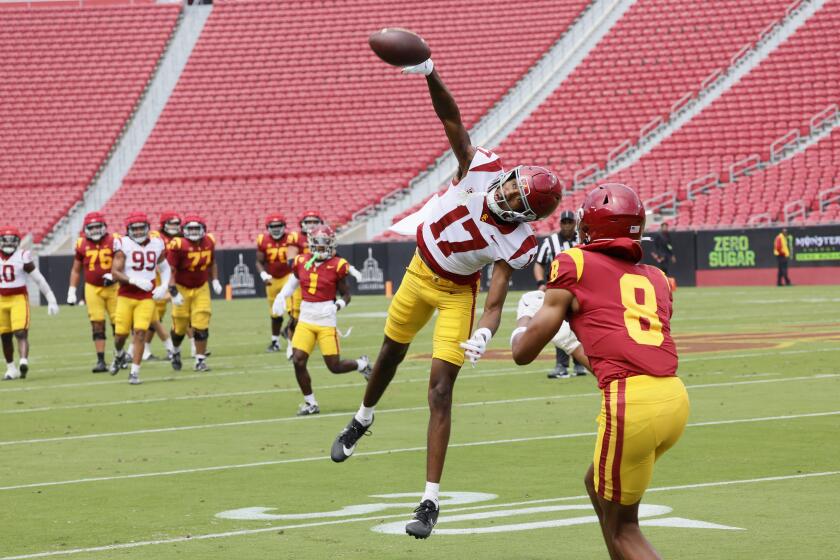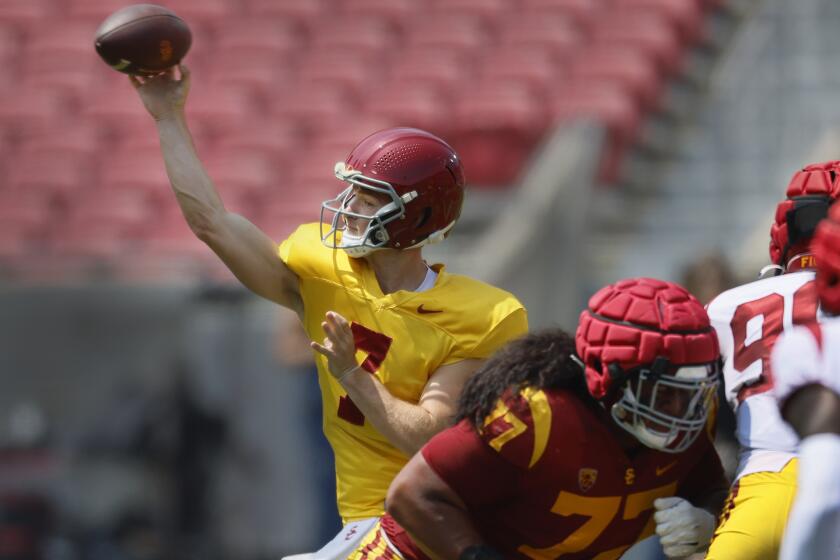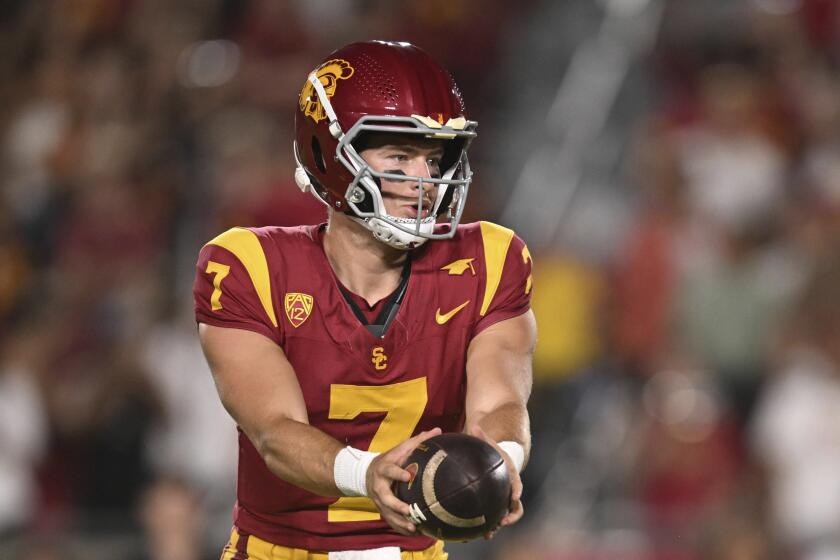Local recruiting is key to USC’s national prowess
It was a simple equation that Pete Carroll settled upon when he arrived as the new football coach at USC six years ago.
The struggling program needed an influx of talent. Southern California ranked among the national hotbeds for young players.
So he would scour the local high schools.
“It seemed like common sense,” Carroll said. “And it seemed like an opportunity to prove our work ethic.”
Recruiting is the lifeblood of college football, an annual dance by which coaches scramble to restock their rosters. In Southern California, it takes vivid form in the rivalry between USC and UCLA.
Most fans judge their annual matchup, which reconvenes Saturday at the Rose Bowl, by the final score. But before the teams even reach the stadium, the outcome is influenced by how they fared in the battle for recruits.
In 2000, Carroll and an assistant, Ed Orgeron, visited a dozen or more schools each day, driving from the Westside to San Bernardino, from Lancaster to Orange County, meeting players and coaches.
“We would go and watch guys work out at 6 in the morning and go till 9 or 10 at night,” recalled Orgeron, now the coach at Mississippi. “It was a buzz saw.”
Winning this behind-the-scenes competition helped Carroll remake the Trojans into a national powerhouse. Now a similar effort has begun in Westwood.
This time, it is UCLA Coach Karl Dorrell trying to invigorate a beleaguered program by winning hearts and minds at local schools. “That’s the challenge,” Dorrell said. “It’s a process of trying to make inroads.”
Keeping ‘em at home
Texas high schools fed 389 players into major college football last summer, according to Scout.com. Florida accounted for 341 and California -- in a statistically off year -- 232.
“Those are always going to be your three biggest states,” said Allen Wallace, the website’s national recruiting editor.
Though USC and UCLA traditionally have subsisted on home-grown talent, they have had to compete against each other and against schools such as Notre Dame, Miami and Oregon to sign these athletes.
The Bruins held the upper hand in the late 1990s as former coach Bob Toledo led them on a 20-game winning streak. But soon after, UCLA appeared to shift its focus to the national scene. “You talked to the City Section coaches and they said they never saw UCLA on campus,” said Greg Biggins of StudentSports.com.
Carroll filled the gap.
Shortly after taking the USC job in December 2000, he and Orgeron drove to Palm Desert to visit Marv Goux, a USC assistant coach during the program’s halcyon days in the 1960s and ‘70s.
“He gave us the plan,” Orgeron said of Goux, who died in 2002. “He let us know how they did it.”
Carroll wanted to “put a fence” around Southern California, keeping all the best players at home. His staff turned recruiting into a contest, assistants returning to the office late at night, comparing notes on how many schools they had visited.
Mike Christensen, the former Lakewood High coach now at Carson High, said he wasn’t used to seeing USC on his campus unless he had a big-time prospect.
“That’s when we knew it was going to be a big change,” Christensen said. “With Carroll, they were going to keep in touch no matter what, in case you had a player down the road they wanted.”
By knowing every campus -- and hosting instructional clinics for high school players -- the Trojans not only formed relationships with top recruits but scouted gems such as LaJuan Ramsey, who went from mediocre college prospect to NFL-caliber defensive lineman.
Add to this method two key elements. Carroll enticed recruits by promising them a chance to play as freshmen. He also brought a strong dose of personality and energy.
“The difference is Pete, in that he hasn’t rested on his laurels,” said Bill Walsh, the former San Francisco 49ers and Stanford coach. “USC’s had the top recruiting class in the country five straight years. There’s a level of athleticism and talent at USC that maybe Ohio State has. Maybe. We’ll find out.”
If USC beats UCLA on Saturday, the Trojans probably will play Ohio State in the national championship game Jan. 8.
The City haul
In the 1990s, as Robert Chai grew up in Newport Beach, UCLA regularly defeated USC. That’s when the promising young center decided to play for the Bruins.
“You want to go with the school that’s winning,” he said.
By the time Chai got to Westwood in fall 2002, however, Carroll had begun to turn the tables.
Now the Trojans were on the upswing, the Bruins sagging.
Dorrell arrived in December 2002, after Toledo was fired, and focused immediately on recruiting. He didn’t have far to look.
Inner-city schools -- some only minutes from Westwood -- complained the Bruins had ignored them. They suspected UCLA did not trust their kids to succeed athletically or academically.
“It’s like red-lining your automobile insurance,” said Robert Garrett, the coach at Crenshaw High. “The attitude had to change.”
Dorrell and former assistant Eric Bieniemy began visiting nearby schools, soothing hurt feelings, repairing relationships.
“I just think that for a while UCLA lacked the aggressiveness they needed,” Wallace said. “Karl Dorrell was recruiting hard.”
Some wondered whether the poker-faced UCLA coach could relate to young players, but the experts heard positive reviews from his campus visits.
Recruits said they were impressed by his past as a star receiver for the Bruins.
“Kids really like Dorrell,” Biggins said. “He’s not as outgoing as Pete, but in real life he’s really nice. He’s got a personality.”
This season, the Bruins have three Crenshaw players on the roster and, more important, a verbal commitment from Crenshaw defensive lineman Brian Price, a five-star prospect recruited by USC and California.
“Now they’re out beating the bushes,” Garrett said of the Bruins. “They’re attacking it the right way.”
Win-win situation
The basic elements of recruiting -- scouting, visiting campuses and homes, offering scholarships -- are the same for every school.
Every coach makes endless calls, sends letters and text messages, nurturing prospects toward signing day in February.
But the nuances can vary based on a crucial issue -- wins and losses.
At UCLA, Dorrell knows he is the underdog and has fashioned his approach accordingly.
“There are some kids who want a winning product right now,” he said. “But a lot of guys want to help build a program and be a part of something special. That’s a great sell.”
Recruiting experts go a step further. By their reckoning, USC figures to snare most of the top 10 local prospects. They say UCLA must chip away by signing the remaining few.
“You don’t want to lose those last couple of kids to Cal or Oregon or whoever,” Biggins said.
Meanwhile, the Trojans are fully aware of the edge they hold.
“You’ve changed a teenage culture,” said Lane Kiffin, who replaced Orgeron as recruiting coordinator. “You’re talking about recruiting juniors in high school and we’ve won five straight Pac-10 titles, so you’re going all the way back to when these kids were in seventh grade.”
The winning streak affords two important advantages.
First, USC can cast a wider net, luring players such as quarterback John David Booty from Louisiana, receiver Dwayne Jarrett from New Jersey and linebacker Keith Rivers from Florida.
Second, Carroll can afford to be patient, waiting to offer scholarships. This gives his staff more time to evaluate and, according to experts, creates a kind of buyer’s frenzy.
“It causes kids to think they are shooting for SC,” Wallace said. “If we want this prize, we’ve got to wait.”
As a result, while UCLA gradually improves its recruiting each season, the national ranking of its high school recruiting class climbing from the 30s into the teens, USC has scored the top-ranked class three of the last four years, according to SuperPrep magazine.
“If USC stayed together for three years, with the same players, they could be an NFL team,” Walsh said. “If somehow USC became the Los Angeles Tornadoes or something, Pete could take them right into the pros and finish in the middle of the pack.”
The question is, how long can the Trojans keep it going?
The program has a mantra repeated by every assistant: The next Matt Leinart, the next Reggie Bush, is right around the corner. This keeps them watching countless videotapes, they say, and driving from school to school across Southern California.
“They’re really aggressive,” Biggins said. “They recruit like they’re a 1-10 team.”
The way Carroll sees it, winning the battle for new talent means winning games against UCLA and everyone else. His formula remains as simple as the day he took the job.
“All you can do,” he said, “is work hard.”
Times staff writer Sam Farmer contributed to this report.
*
(BEGIN TEXT OF INFOBOX)
Next in line
These top high school seniors have orally committed their intent to accept football scholarships to USC or UCLA in 2007:
USC
*--* Name High school Pos. Rk.* Broderick Green Pulaski Academy (Ark.) RB 6 Jordan Campbell Norco WLB 10 James Wilson Nease (Fla.) OG 2 Marshall Jones Oaks Christian S 12 Marc Tyler Oaks Christian RB 2 Michael Reardon Orange Lutheran DE 13 Aaron Corp Orange Lutheran QB 8 Samson Szakacsy Camarillo QB 44 Martin Coleman H.B. Edison OT 5 Chris Galippo Servite MLB 1
*--*
*
UCLA
*--* Name High school Pos. Rk.* Akeem Ayers Verbum Dei DE 14 Steve Sloan San Jose Mitty SLB 7 Nate Chandler Mira Mesa (San Diego) TE 6 Chris Forcier St. Augustine (San Diego) QB 17 Courtney Viney Fresno Edison CB 9 Raymond Carter Crenshaw RB 16 Brian Price Crenshaw DT 7
*--*
* National ranking, by position
Source: Los Angeles Times staff
---
Class action
Recruiting classes ranked by SuperPrep magazine:
*--* 2006 2005 2004** 2003 2002* 2001 2000
USC 1 3 1 1 7 19 11
UCLA 19 27 31 32 6 10 24
*--*
* Pete Carroll’s first full recruiting class at USC; ** Karl Dorrell’s first full recruiting class at UCLA
Go beyond the scoreboard
Get the latest on L.A.'s teams in the daily Sports Report newsletter.
You may occasionally receive promotional content from the Los Angeles Times.




